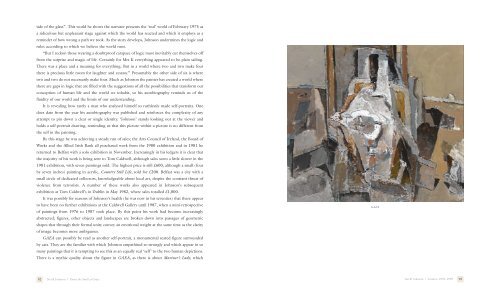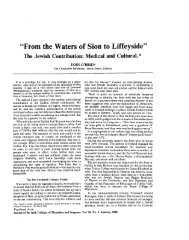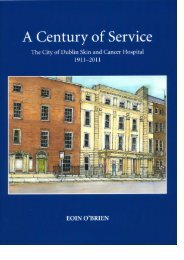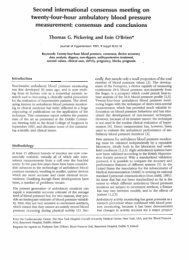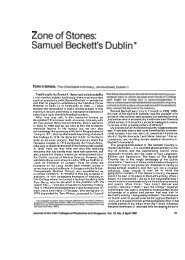Nevill Johnson: Paint the smell of grass - Eoin O'Brien
Nevill Johnson: Paint the smell of grass - Eoin O'Brien
Nevill Johnson: Paint the smell of grass - Eoin O'Brien
Create successful ePaper yourself
Turn your PDF publications into a flip-book with our unique Google optimized e-Paper software.
side <strong>of</strong> <strong>the</strong> glass”. This world he shows <strong>the</strong> narrator presents <strong>the</strong> ‘real’ world <strong>of</strong> February 1975 as<br />
a ridiculous but unpleasant stage against which <strong>the</strong> world has reacted and which it employs as a<br />
reminder <strong>of</strong> how wrong a path we took. As <strong>the</strong> story develops, <strong>Johnson</strong> undermines <strong>the</strong> logic and<br />
rules according to which we believe <strong>the</strong> world runs.<br />
“But I reckon those wearing a doubtpro<strong>of</strong> carapace <strong>of</strong> logic must inevitably cut <strong>the</strong>mselves <strong>of</strong>f<br />
from <strong>the</strong> surprise and magic <strong>of</strong> life. Certainly for Mrs K everything appeared to be plain sailing.<br />
There was a place and a meaning for everything. But in a world where two and two make four<br />
<strong>the</strong>re is precious little room for laughter and ecstasy.” Presumably <strong>the</strong> o<strong>the</strong>r side <strong>of</strong> six is where<br />
two and two do not necessarily make four. Much as <strong>Johnson</strong> <strong>the</strong> painter has created a world where<br />
<strong>the</strong>re are gaps in logic that are filled with <strong>the</strong> suggestions <strong>of</strong> all <strong>the</strong> possibilities that transform our<br />
conception <strong>of</strong> human life and <strong>the</strong> world we inhabit, so his autobiography reminds us <strong>of</strong> <strong>the</strong><br />
fluidity <strong>of</strong> our world and <strong>the</strong> limits <strong>of</strong> our understanding.<br />
It is revealing how rarely a man who analysed himself so ruthlessly made self-portraits. One<br />
does date from <strong>the</strong> year his autobiography was published and reinforces <strong>the</strong> complexity <strong>of</strong> any<br />
attempt to pin down a clear or single identity. ‘<strong>Johnson</strong>’ stands looking out at <strong>the</strong> viewer and<br />
holds a self-portrait drawing, reminding us that this picture-within-a-picture is no different from<br />
<strong>the</strong> self in <strong>the</strong> painting.<br />
By this stage he was achieving a steady run <strong>of</strong> sales; <strong>the</strong> Arts Council <strong>of</strong> Ireland, <strong>the</strong> Board <strong>of</strong><br />
Works and <strong>the</strong> Allied Irish Bank all purchased work from <strong>the</strong> 1980 exhibition and in 1981 he<br />
returned to Belfast with a solo exhibition in November. Increasingly in his ledgers it is clear that<br />
<strong>the</strong> majority <strong>of</strong> his work is being sent to Tom Caldwell, although sales seem a little slower in <strong>the</strong><br />
1981 exhibition, with seven paintings sold. The highest price is still £600, although a small (four<br />
by seven inches) painting in acrylic, Country Still Life, sold for £200. Belfast was a city with a<br />
small circle <strong>of</strong> dedicated collectors, knowledgeable about local art, despite <strong>the</strong> constant threat <strong>of</strong><br />
violence from terrorists. A number <strong>of</strong> <strong>the</strong>se works also appeared in <strong>Johnson</strong>’s subsequent<br />
exhibition at Tom Caldwell’s in Dublin in May 1982, where sales totalled £1,800.<br />
It was possibly for reasons <strong>of</strong> <strong>Johnson</strong>’s health (he was now in his seventies) that <strong>the</strong>re appear<br />
to have been no fur<strong>the</strong>r exhibitions at <strong>the</strong> Caldwell Gallery until 1987, when a mini-retrospective<br />
<strong>of</strong> paintings from 1976 to 1987 took place. By this point his work had become increasingly<br />
abstracted; figures, o<strong>the</strong>r objects and landscapes are broken down into passages <strong>of</strong> geometric<br />
shapes that through <strong>the</strong>ir formal unity convey an emotional weight at <strong>the</strong> same time as <strong>the</strong> clarity<br />
<strong>of</strong> image becomes more ambiguous.<br />
GAEA can possibly be read as ano<strong>the</strong>r self-portrait, a monumental seated figure surrounded<br />
by cats. They are <strong>the</strong> familiar with which <strong>Johnson</strong> empathised so strongly and which appear in so<br />
many paintings that it is tempting to see this as an equally real ‘self’ to <strong>the</strong> two human depictions.<br />
There is a mythic quality about <strong>the</strong> figure in GAEA, as <strong>the</strong>re is about Mariner’s Lady, which<br />
92 <strong>Nevill</strong> <strong>Johnson</strong> l <strong>Paint</strong> <strong>the</strong> Smell <strong>of</strong> Grass<br />
GAEA<br />
<strong>Nevill</strong> <strong>Johnson</strong> l London 1978–1999 93


